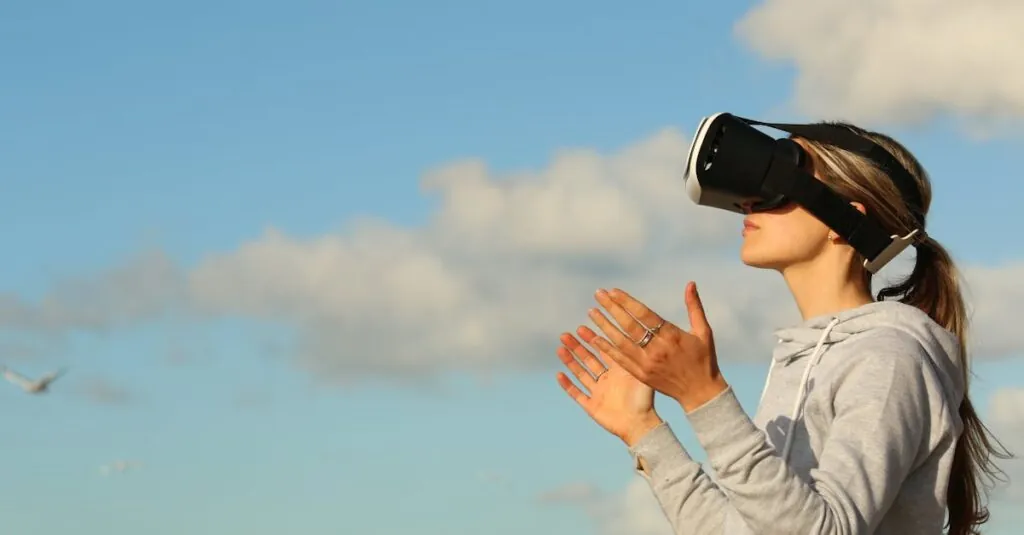Imagine slipping on a headset and suddenly finding yourself in a world where you can soar like a superhero or explore the depths of the ocean without getting wet. Virtual reality isn’t just a sci-fi dream; it’s a thrilling reality that’s reshaping how people experience entertainment, education, and even social interactions.
Table of Contents
ToggleOverview of Virtual Reality
Virtual reality (VR) creates immersive digital environments that users can interact with as if they’re real. Technologies that drive VR include headsets, controllers, and motion-sensing devices. These tools enhance the sense of presence in virtual worlds, transforming how people engage with digital content.
Applications of VR span diverse fields. In entertainment, gamers experience rich, interactive worlds where they feel part of the story. Educational institutions use VR to simulate complex scenarios, allowing students to practice skills in controlled settings. Medical training employs VR for procedures, enabling practitioners to refine techniques without risking patient safety.
The social aspect of VR also flourishes. Users connect with others in virtual spaces, participating in shared experiences regardless of physical distance. Events like virtual concerts attract thousands, bridging gaps and creating a sense of community. Businesses leverage VR for remote collaboration, fostering teamwork among individuals in different locations.
Research indicates that the VR market is projected to grow significantly. By 2026, the global market could reach $57.55 billion, showcasing increasing interest from various sectors. Enhanced accessibility through mobile VR solutions and advancements in hardware promises widespread adoption.
Challenges persist within the VR landscape. Motion sickness remains a concern for some users, limiting long-term use. High costs associated with advanced VR systems also pose barriers for entry. Continuous technological improvements aim to address these issues, making VR experiences more enjoyable and accessible.
Understanding virtual reality’s potential requires ongoing exploration. As this technology evolves, its impact on daily life, from entertainment to education, will likely expand.
Applications of Virtual Reality
Virtual reality (VR) technology finds numerous applications across various fields. Notably, it enhances experiences in gaming, education, and healthcare.
Gaming
Gamers engage deeply with immersive environments created by VR. Realistic graphics and interactive gameplay transport players to fantastical worlds. Titles like “Beat Saber” and “Half-Life: Alyx” showcase how VR brings new dimensions to gaming. Players connect with others online for cooperative or competitive experiences. These social interactions enrich the gaming landscape, fostering community and collaboration.
Education and Training
Educational institutions integrate VR to transform learning experiences. Students explore historical events or scientific phenomena in lifelike simulations. This approach enables skill practice in safe environments, such as medical training programs using VR for surgical procedures. Benefits include increased retention of information and improved engagement during lessons. Teachers utilize VR to provide unique opportunities that enhance the curriculum.
Healthcare
Healthcare professionals use VR for various training and therapeutic applications. Medical students practice surgical techniques in realistic, risk-free settings. Therapists leverage VR for treating conditions like PTSD or phobias through exposure therapy. Patients experience calming environments during rehabilitation, aiding recovery. Research emphasizes the importance of VR in improving patient outcomes and clinician education.
Benefits of Virtual Reality
Virtual reality (VR) offers numerous advantages across various domains, significantly enhancing user experiences.
Enhanced Engagement
Engagement levels soar when users interact within a virtual environment. Users feel a heightened sense of reality, allowing for deeper involvement in activities. Game designers create immersive experiences, captivating individuals and groups alike. Events like virtual concerts or exhibitions draw larger audiences than traditional settings. According to recent studies, users display increased focus and retention while participating in VR activities. These interactive experiences garner attention, resulting in memorable moments. Educators report that students actively engage with course materials when incorporated into VR settings.
Improved Learning Outcomes
Learning outcomes improve significantly through virtual reality applications. Students grasp complex concepts more effectively when visualized in 3D environments. Simulations allow individuals to practice skills safely, enhancing retention of knowledge. Research shows that learners using VR report higher satisfaction and comprehension rates compared to conventional methods. Medical students demonstrate increased proficiency in techniques after training with VR simulations. Historical events come alive for learners, fostering a deeper understanding of context and significance. Thus, VR serves as a powerful tool in classrooms and training facilities across disciplines.
Challenges and Limitations of Virtual Reality
Virtual reality faces various challenges that impact its growth and user experience. Significant barriers exist in the technical aspects and health concerns associated with extended use.
Technical Barriers
High costs of VR equipment hinder widespread adoption for many users. Advanced systems require substantial investments, making them inaccessible to a broader audience. Compatibility issues with existing platforms and software often limit VR’s usability. Developers encounter challenges when creating content that works seamlessly across different devices. Furthermore, ongoing advancements in technology lead to rapid obsolescence of older hardware, complicating users’ choices. Motion tracking technologies can struggle in poorly lit environments, affecting immersion. Sound design can also falter, leading to distractions that pull users out of the experience. Despite these challenges, advancements in mobile VR solutions are promising.
Health Concerns
Health issues related to VR usage pose another challenge. Motion sickness affects many users, stemming from the disconnect between visual input and physical movement. Symptoms can include dizziness, nausea, and headaches, leading users to limit their time in VR environments. Eye strain occurs due to prolonged use of headsets, especially among newer users not accustomed to the technology. Reports indicate that users may experience discomfort after only short sessions. Cognitive overload can occur, overwhelming some individuals with stimuli in immersive environments. Addressing these health concerns requires ongoing research and technology improvements to ensure safe and pleasant experiences in virtual reality.
The Future of Virtual Reality
Anticipated advancements in virtual reality (VR) signal its growing influence across multiple sectors. Experts project that the VR market could reach $57.55 billion by 2026, driven by innovations in mobile VR technology and hardware. Accessibility must improve to overcome high costs, ensuring more users can experience these virtual environments.
Improvements in user experience play a crucial role in VR’s evolution. Companies are focusing on minimizing motion sickness and enhancing motion tracking, which directly impacts immersion. Better sound design will contribute to the overall realism of experiences, enabling users to feel more connected to virtual worlds.
VR’s potential in education stands out prominently. Simulations allow students to interact with complex scenarios, resulting in improved retention rates compared to traditional methods. Enhanced proficiency among medical students using VR for surgical training illustrates the technology’s effectiveness in professional development.
Social interactions in VR environments continue to gain traction. Users engage in shared experiences, such as virtual concerts, which fosters community regardless of geographical barriers. Opportunities for collaboration in the business setting are also expanding, making remote teamwork more effective than ever.
Technological innovations address the challenges facing VR. Ongoing research aims to tackle health concerns like cognitive overload and eye strain, ensuring enjoyable, safe experiences for all users. As these developments progress, the boundaries of reality and imagination blur further, with implications for daily life across entertainment, education, and healthcare expanding significantly.
Virtual reality is reshaping how individuals engage with the world around them. Its immersive experiences are not just limited to entertainment but extend into education, healthcare, and business, enhancing learning and collaboration. As technology advances, VR will likely become more accessible, overcoming current barriers like high costs and health concerns.
The future of VR holds immense potential, with innovations promising to enrich user experiences and expand applications across various sectors. As it continues to evolve, the impact of virtual reality on daily life is set to grow, offering new ways for people to connect, learn, and thrive in an increasingly digital landscape.






